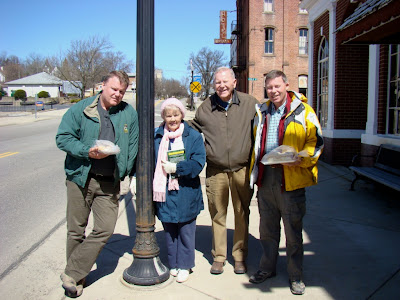Like a glacier of living things, spring steamrolls north at the rate of about seventeen miles a day. While the first signs of vernal life become apparent in March, the dam bursts in April and floods Ohio’s landscape with harbingers that can’t be missed.
April is the month of spring, more than any other. The fore part of March is still brown and carries much of winter’s bite, and the latter part of May has greened into summer. The fourth month is nothing but an explosive burst of life on every front.
On an April fool’s day trip to southern Ohio’s Shawnee State Forest, I was dazzled by the blooms of redbuds and sassafras, and a plethora of spring wildflowers brightening the forest floor. A visitor to northernmost Ohio that same weekend would have encountered a land still locked in winter’s remnants. But northerners can take hope: they’ll be treated to much the same scenery by month’s end.
As the earth’s crust thaws, but before overarching trees blanket the forest in shade, a profusion of sun-loving wildflowers bursts forth. These include many of our showiest, like spring-beauty, large-flowered trillium, and bloodroot.
Along with the flowers come early butterflies seeking nectar. In Shawnee, I saw ten species of butterflies, many in abundance. Among their ranks were massive tiger swallowtails, diminutive Henry’s elfins, and outrageously colored falcate orangetips. Like a glittering army, they swarmed the early blooms of spring. By month’s end, many other species will have joined their ranks, and butterflies will again grace all corners of the state.
Our state tree, the Ohio buckeye, is among the first woody plants to unfurl its leaves and push forth stunning spikes of yellowish flowers. The gorgeous but deceptive flowering dogwood also hits its stride in April. It’s a trickster; those big white flowers are not flowers at all. They are modified leaves - bracts - which appear to have been dipped in white paint. The true flowers are tiny, greenish, and altogether unremarkable. Serviceberry, or shadbush, peaks this month. These small trees festoon the leafless woodlands with sprays of white flowers. The shadbush moniker stems from the blooms coinciding with the spring run of shad up creeks and rivers.
To many nature enthusiasts, birds are the favorite passage of spring. The miracle of migration has evolved over eons, and Ohio plays a vital part. Of our 180 species of breeding birds, one-third winter in the tropics of Central and South America. Even more species of tropical birds pass through on their way to northerly nesting grounds, and our habitats are critical to resting and fueling them on their long journey.
Brilliantly-hued orange and black Baltimore orioles that will soon announce themselves here with loud, piping whistles spent the winter in far warmer climes. Perhaps in lowland Costa Rican jungles, where they fraternized with tropical species like Montezuma’s oropendolas and bright-rumped attilas.
Our tiniest avian breeder, the ruby-throated hummingbird, is now returning. These sprites, weighing the same as a penny, came all the way from southern Mexico. Jumping off from the Yucatan peninsula, hummers fly nonstop 500 miles across the Gulf of Mexico before grounding out in Texas or Louisiana. In the course of that amazing water crossing, one will beat its wings 4.5 million times. The tiny heart will pump 1.2 million times before landfall and a rest. The urge to return north and reproduce is an incredible force.
Many of the plants that are conspicuous now in our neighborhoods are not native. While pretty, the Bradford pears, daffodils, and tulips don’t represent the spectacular native biodiversity of Ohio. Take time to visit a place like Highbanks Metropark or Shawnee State Forest. In those places, you’ll find far more special plants doing what they’ve done every spring for eons. Along with the flora is an amazing assortment of animals that have co-evolved with them in a harmony of nature that no human hand could hope to orchestrate.





















































